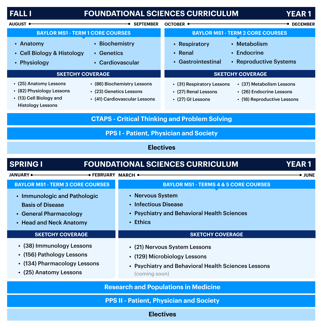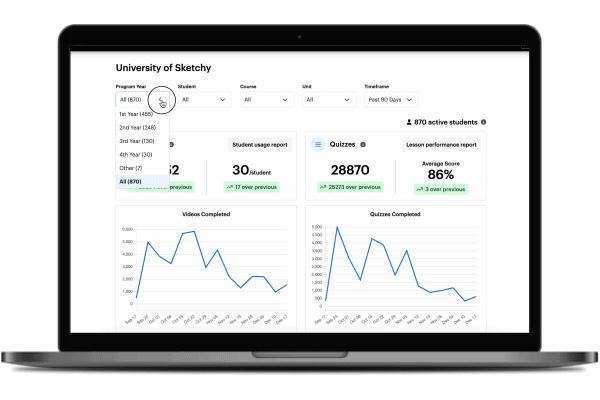In the dynamic landscape of medical education, leveraging a flipped classroom model with external resources like Sketchy can significantly enhance student engagement and learning outcomes. This approach transitions from passive absorption to active engagement, a change supported by a meta-analysis in BMC Medical Education, which found flipped classrooms to improve learning in health professions. This represents a transformative change in educational methodology. By integrating Sketchy into pre-class assignments, students arrive prepared, enhancing in-class discussions and activities. This approach not only aligns with modern pedagogical techniques but also caters to diverse learning styles, simplifying intricate subjects and preparing students for medical practice challenges. Let’s explore a step-by-step guide on how to effectively incorporate Sketchy into a flipped classroom in medical schools.
Step 1: Gaining Faculty Buy-In for a Flipped Classroom Approach
- Highlight the Benefits: Present the advantages of the flipped classroom model, such as increased student engagement, improved understanding of complex concepts, and enhanced active learning opportunities. Use evidence from existing literature, like the work of Bishop and Verleger, to support your argument.
- Showcase Success Stories: Share success stories and case studies from other institutions that have successfully implemented a flipped classroom model. Demonstrating real-world examples can be a powerful motivator.
- Address Concerns and Challenges: Be ready to discuss potential challenges and concerns, such as the need for additional preparation time or uncertainty about technology. Offer solutions and support to address these challenges.
- Provide Training and Resources: Offer training sessions and resources to help faculty effectively implement the flipped classroom model. This includes how to use external tools like Sketchy, and how to design and facilitate in-class activities.
Step 2: Align Sketchy with Your Curriculum
- Curriculum Mapping: Sketchy works directly with your faculty to align our curriculums together. We begin by conducting a detailed curriculum mapping process. Together, we evaluate your course objectives, topics, and timelines, and align them with the content available in Sketchy. Ensure that each Sketchy course, module or video directly corresponds to specific learning goals in your curriculum.

Interested in seeing how your school's curriculum maps to Sketchy's material?
- Faculty Collaboration: Collaborate with other faculty members to ensure a cohesive integration of Sketchy’s content across different courses and modules. Share best practices and strategies for effective utilization of these resources.
Step 3: Pre-Class Assignments
- Assign Relevant Content: Assign specific Sketchy videos as mandatory pre-class preparation. Choose content that lays the groundwork for upcoming class topics, ensuring students come prepared with a basic understanding of key concepts. This approach primes students for deeper understanding and active participation in class, fostering critical thinking.
- Track Student Engagement: Utilize Sketchy’s Faculty Insights Dashboard to track students’ usage and engagement with the assigned content. This can help in understanding how well the students are preparing and where they might need additional support.

Get detailed analytics on your students’ usage and progress with Sketchy’s Faculty Insights Dashboard
Step 4: Utilize Class Time for Application
- Interactive Learning Activities: Design class activities that encourage students to apply the knowledge they gained from Sketchy. This could include case discussions, role-playing, or clinical scenario analyses that require students to use their pre-class learning in practical ways. Classes become interactive workshops where students discuss case studies, engage in simulations, and participate in problem-solving exercises.
- Peer Teaching: Encourage students to explain concepts to their peers, leveraging their pre-class exposure to Sketchy Medical. This method reinforces their understanding and fosters collaborative learning.
Step 5: Encourage Active Learning and Discussion
- Guided Discussions: Lead discussions that connect Sketchy’s content with real-life clinical cases or recent research. Pose open-ended questions that provoke critical thinking and deeper analysis.
- Incorporate Diverse Perspectives: Encourage students to bring their own insights and interpretations to the discussion, fostering a richer, more diverse learning experience.
Step 6: Continuous Assessment and Feedback
- Regular Quizzes and Assessments: Conduct regular quizzes or assessments based on both Sketchy’s content and in-class activities. This approach helps in continuously evaluating student understanding and retention.
- Feedback Mechanisms: Provide timely and constructive feedback to students, both on their performance in assessments and their participation in class. Encourage them to reflect on their learning process and identify areas for improvement.
- Track Progress: Regularly monitor Sketchy’s Faculty Insights Dashboard to track student study habits and quiz score improvement over time.
Step 7: Adapt to Student Feedback
- Student Surveys and Feedback Sessions: Regularly gather student feedback on the use of Sketchy and its integration into the curriculum. This could be through surveys, focus groups, or informal feedback sessions.
- Iterative Improvement: Use the feedback to make iterative improvements to the integration strategy. Be open to experimenting with different approaches to find what works best for your students.
Conclusion
Integrating external resources like Sketchy into the flipped classroom model offers a multifaceted approach to medical education. It not only aligns with modern pedagogical strategies but also caters to diverse learning styles, making complex medical concepts more digestible and engaging. As medical educators, embracing such innovative tools is key to enhancing the educational experience and preparing students for the challenges of medical practice.
Interested in exploring ways to use Sketchy with your students? Book a meeting today.
References:
- Berrett, D. (2012). How 'Flipping' the Classroom Can Improve the Traditional Lecture. The Chronicle of Higher Education. Retrieved from https://www.chronicle.com/article/how-flipping-the-classroom-can-improve-the-traditional-lecture/
- Bishop, J. L., & Verleger, M. A. (2013). The Flipped Classroom: A Survey of the Research. 120th ASEE Annual Conference and Exposition. Retrieved from https://www.asee.org/public/conferences/20/papers/6219/view
- Harvard’s Bok Center for Teaching and Learning. Flipped Classrooms. Retrieved from https://bokcenter.harvard.edu/flipped-classrooms
- Tune, J. D., Sturek, M., & Basile, D. P. (2013). Flipped classroom model improves graduate student performance in cardiovascular, respiratory, and renal physiology. Advances in Physiology Education, 37(4), 316-320. Retrieved from https://journals.physiology.org/doi/full/10.1152/advan.00091.2013
- Hew, K. F., & Lo, C. K. (2018). Flipped classroom improves student learning in health professions education: a meta-analysis. BMC Medical Education, 18(1), 38. https://doi.org/10.1186/s12909-018-1144-z